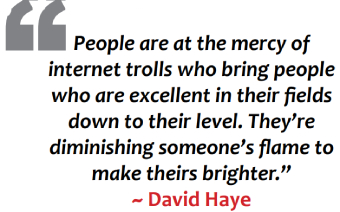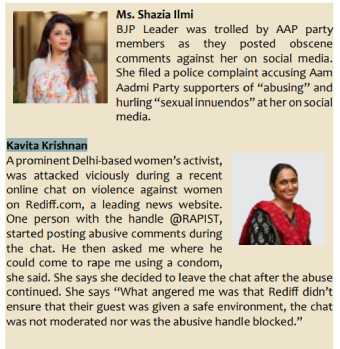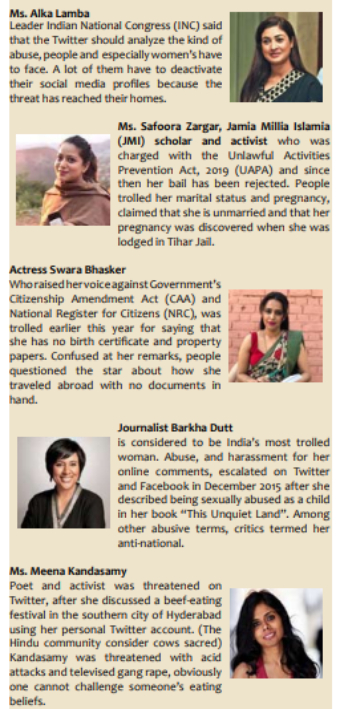September 25, 2020
Trolling a New form of Cyber Violence; Threat to Women & Girls
– Sheetal Raghuvanshi, Advocate & Legal Consultant [ ]
INTRODUCTION
The most empowered tool in today’s society is “Internet” or “Cyber World”. It is this technological advancement which emerged as the most popular means of socialization and has been aptly termed social media. Access to the internet has enabled many people to overthrow barriers and actively participate in public life. Today, we all are connected, 24/7, no matter where in the world, we are just one click away from our families, co-workers, classmates, mentors, neighbors, and even strangers. On one hand, the Internet has made the world a much smaller place with hand full of opportunities for people along with bringing awareness to important socio political movements and also given them a platform for many noble causes; on the other hand, it has exposed vulnerable people to a deep dark world of web and bullying by anonymous people sitting safely at their homes. The Indian telecom industry registered strong growth in the recent years and has become the second-largest telecommunications industry in the world. The country also ranked second in terms of total internet user worldwide in 2019.1
The risk of “cyber violence” is alarming and its assessment and prevention has become even more urgent.2 In India, this situation has risen, due to increasing access to technology, inexpensive internet plans and politicians vehemently pursuing and pushing the dream of “Digital India”. The majority of population has access to the Internet through a computer, a tablet, or mostly on a mobile device.3 Though the online violence can affect both women and men, women and girls experience different and more traumatic forms of cyberbullying. The most vulnerable of our population are our women and girls, who are being catapulted into cyberspace before they are actually capable of making sense of it psychologically.4

A heavy cost had to be paid by the women and other marginalized groups, who face online violence and abuse for expressing their viewpoints on social media. Social media has become a platform for communication, but it is also being used to abuse, harass, incite, and manipulate others. As indicated by the most recent Data of National Crime Records Bureau, the number of cyber-crimes have been steadily increasing each year.5 The highest number of cyber-crimes in 2017 had been in Uttar Pradesh, followed by Maharashtra, Karnataka, Rajasthan,Telangana.6
Cyber Crime
Online abuse or Cyber Crime is not defined in any statute, neither in Information Technology Act 2000 nor in the I.T. Amendment Act 2008. “The combination of crime and computer”. To simplify cybercrime is any type of illegal activity that takes place via digital means.7
Types of cyber-crimes against women:
Harassment via E-mail
This form of cybercrime includes blackmailing, threatening, and constant sending of love letters through anonymous names or regular sending of demeaning and shaming mails to one’s mail box.8
Cyber stalking
“Cyber stalking” is defined as a crime where the stalkers use internet or any other electronic device to stalk someone. It involves a conduct of harassing or repeated threats to an individual.9 The motive of stalkers may be the following, (i) sexual harassment, (ii) obsession for love (iii) revenge and hatred, (iv) ego and power. The stalker harasses their targets through private emails as well as public message. Mostly the target of cyber stalking are women in of the age group of 16 to 35 years.10
Cyber pornography
Cyber pornography is the act of using the cyber space to create, publish or disseminate pornographic materials. Porn today is more freely and widely available on Internet than ever before. Younger generation is therefore able to access it very easily and quickly than ever. This leads to the mentality of emotionless sex and commodifying women.
Morphing
When unauthorized user with fake identity downloads victim’s pictures and then uploads or reloads them after editing, it is known as morphing.11 Morphing involves editing the original picture by an unauthorized user – when an unauthorized user with fake identity downloads the victim’s pictures and then uploads or reloads them after editing. It is a common phenomenon that women’s pictures are downloaded from websites by fake users and again reposted/ uploaded on different websites by creating fake profiles after editing them.12

Nowadays, a new tool called ‘deep fakes’ has emerged where technology allows to put anybody’s face over someone else’s face. Once the face is changed, technology also allows to whatever words you want the face to speak. This technology is used to create lot of fake videos to change the peoples’ perception about someone. Unfortunately, most people fall for it and believe it to be true. Even celebrities are not spared, and fake videos, MMS of celebrities continue appearing in cyberspace.
Email spoofing and impersonation
E-mail spoofing is described as the fraudulent email activity in which the sender’s address and other parts of the email header are altered to appear as though the email originated from a known or authorized source. By changing certain properties of the email, such as its header, from, Return-Path and Reply-To fields etc., hostile users can make the email appear to be from someone other than the actual sender.
Online trolling/bullying/threat/blackmailing/ Meme making
Online harassment of women in India has become a menace, with the growth of Toxicity on Twitter. The increase in number of trolls on internet there are only two recourse left with the women and girls, from either logging off to protect their mental health and safety or calling out their and others’ online harassers.13 More than 90 million Indians are active users of Facebook and Twitter and a large number of them are women.
Mr Jaishankar, a teacher of criminology who has been studying bullying, stalking and defamation of women online, says India’s “patriarchal mindset has pervaded the internet space”. He counsels victims of cybercrime along with his colleague and lawyer DebaratiHaldar, says that Indian online users are largely male introverts who have found the web a space where they can express themselves freely and anonymously. Men don’t like women to talk back. Public personalities who express strong opinions are trolled in a bid to force them offline. Initially, Twitter was considered to be the ‘safe place for free expression’, which was visualized as a space where marginalized persons, including women, Dalits and religious minorities, would have an equal opportunity to of being heard. But nowadays, it has become an infamous trolling platform.

Following are glaring example of famous ladies being trolled and shamed on the Twitter:
Sagarika Ghose, a well-known face of Indian television news, who anchors prime-time bulletins on CNN-IBN is threatened regularly with gang rape and stripping on Twitter and her teenage daughter’s name and details of her class and school were tweeted too. She says “Targeting me for my journalism is fine. But when it is sexist and vulgar which insults my gender identity I get irritated. In the beginning I used to retaliate, but that would lead to more abuse. The abusers are angry at women speaking their mind”. MsGhose has now decided to stop putting her views on Twitter.14
Violence against women on Twitter can be direct or indirect threats, physical or sexual violence, abuse targeting woman’s identity, such as racism or transphobia. The aim of such violence and abuse is to create an aggressive environment online for women with the goal of shaming, degrading, intimidating, belittling and ultimately silencing them.15
Laws in India: Do they really protect from online abuse against women?
Information Technology Act:
• Section 66E penalizes the violation of a person’s privacy by intentionally capturing and publishing images of a private area of any person without his or her consent.
• Section 67 punishes electronic publication or transmission of obscene material.
• Section 67A deals particularly with the electronic publication or transmission of material that contains sexually explicit acts.
• Section 67B relates to material depicting children in sexually explicit acts and includes under its purview not only those who create and publish but also whoever downloads digital images depicting children engaged in sexually explicit act or conduct. Indian Penal Code:
• Section 354A punishes sexual harassment, including making sexually coloured remarks.
• Section 354C punishes voyeurism that is capturing or disseminating images of a woman engaged in a private act in circumstances where she expects privacy
• Section 354D punishes stalking, especially online stalking.
• Section 503 prohibits criminal intimidation, including issuing physical threats to a person.
• Section 506 punishes criminal intimidation by ‘imputing unchastity’ to a woman.
• Section 509 punishes words, gestures or acts intended to insult the modesty of a woman or to intrude upon her privacy. The Indecent Representation of Women (Prohibition) Act
• Section 4 prohibits the publication of any printed material containing indecent representation of women. Protection of Children from Sexual Offences Act
• Section 11 defines and makes sexual harassment a punishable offence
• Section 12 penalizes sexual harassment of a child.
• Section 13 makes the use of children for pornographic purposes a punishable offence.
• Section 14 penalise anyone who uses a child for pornographic purposes.
Problems identified:
• Woman and girl cyber harassment remain underreported due to social stigma and tendency of parents not to involve police in such matters.

• Women’s and Girls are mostly unaware about privacy policies and safety tips for using social media sites because they are less proficient in using technology.
• Cyber laws have not been formulated properly and the procedure for registering a complaint or reporting a crime is not known by woman due to which many cases go unreported. The data composed by NCRB is not updated on a regular basis which shows that there is need for stricter enforcement agency.
Cyber criminals use digital media to harass women and even legal system is not defining the cyber laws in a holistic way. There is a need to use law as an instrument of change and thus, law makers should focus upon substantive equality. As like trolling should be defined well and scope of the cyber laws must get widened. Major legal lacuna i.e. having no clause for many common cybercrimes in legal system.
The Service providers and the pages like Twitter and Facebook are not cooperative enough and their terms and conditions are also not stringent because of which the tweets, especially on Twitter can’t be stopped.
Increase in Cyber Crimes Against Women During Lockdown:
It has been noticed that the period of social distancing and misinformation during COVID-19 also gave an opportunity to the dark elements of the society. There has been an increase of fake apps, domain names and websites capitalizing on two facts, first, the fear among the general public and their search for information related to this pandemic and secondly, the companies across the globe are turning to ‘work from home’ via the online medium.16
Suggestions and Proposed Solutions:
• The Government must encourage women to report when criminals violate their rights online.
• The Government should ensure that users privacy is protected and that they are not subject to monitoring.
• There should be a Digital Police Portal/E-Portal, with special cell for trolling where woman can report their problems online. Through this there could be more of reported cases.
• Government should create an environment in which individuals feel confident enough to report online abuse to authorities, even if this challenges cultural norms and takes time
• Stop dismissing reports of sexualized or gender-based abuse because they take place on the internet.
• Educate officers that the response to online harassment is not to stop the victim using the internet.
• There should be implementation of stricter laws regardless of their political or religious agenda.
• Social media sites should have fast & effective responses to complaints & should encourage women and girls to immediately report objectionable messages.
• Employ local staff, particularly grievance officers, to ensure that workers can adequately evaluate complaints about posts made in local languages based on local cultural context.
• The different handles should check their policies and make it more flexible, especially for marginalized genders and sexualities, journalists, and whistle-blowers under threat.
• Girls should be made aware about all types of cybercrimes and how to handle them. Spreading awareness regarding safe internet uses and complying procedure should be done among the woman.
Direction issued by NCW and DCW in below-mentioned cases:
• Chairperson National Commission for Women Ms. Rekha Sharma has written to Shri SubodhJaisewal, DGP Maharashtra to take legal action against Faizal Siddiqui for the video he posted that promotes a grievous crimes of acid attack on social media using TikTok App. Considering the sensitivity of the matter, it was requested to take immediate actions under IT Act 2000.
• Ms Swati Maliwal Chairperson Delhi Commission for Women in receipt of multiple complaints regarding abuse and character assassination of SafooraZargar, and the vilification campaign that is being run against her has issued a notice to the Deputy Commissioner Of Police, Special Cell, Delhi and has asked for the :
1 Copy of FIR registered in the matter of online abuse and attacks on SafooraZargar.
2 Details of the accused identified and arrested in the matter.
3 Measures taken to remove the posts outraging her modesty from social media.
Conclusion
It is high time that we took online abuse against women more seriously. We need to ensure women are able to express themselves online without fear. We need to create safe spaces for women to talk about the abuse they face. And we need to improve the implementation of existing laws. For a start, social media companies must be urged to follow their own community standards and rules relating to abuse against women on their platforms.
This increased rate of cyber-crime against women has led to development of insecurity in a woman. They don’t feel safe anymore, anywhere. Its effects are worse on them and on the society as a whole, when we look into the broader picture.17
1 Internet users in India to reach 627 million in 2019: Report, https://economictimes.indiatimes.com/tech/internet/internet-users-in-india-to-reach-627-million-in-2019-Mar 06, 2019, 05.56 PM IST
2 Cyber crimes involving morphed photos rising http://timesofindia.indiatimes.com/articleshow/47861480.cms?utm_source=contentofinterest&utm_medium=text&utm_campaign=cppst,
November
2012 with 23,138.
3 id
4 id
5 5https://timesofindia.indiatimes.com/city/jaipur/Cyber-crimes-involving-morphed-photos-rising/articleshow, Jun 29, 2015, 12:13 IST
6 id
7 Dr. SHAIKH AHMAD S/O SHAIKH ISMAIL, “ STUDY OF THE CYBER CRIMES AND THE LAWS RELATED TO THE WOMENS IN INDIA”
8 Shobhna Jeet , Cyber crimes against women in India: Information Technology Act, 2000, 12 June 2012,page 4
9 id
10 id.
11 id
12 Dr. SHAIKH AHMAD S/O SHAIKH ISMAIL , “ STUDY OF THE CYBER CRIMES AND THE LAWS RELATED TO THE WOMENS IN INDIA”, page no 9
13 https://amnesty.org.in/trolling-verifi ed-troll-patrol-indias-fi ndings-on-online-abuse-twitter/
14 By Divya AryaBBC Hindi, Delhi, 8 May 2013,https://www.bbc.com/news/world-asia-india
15 15VIOLENCE AGAINST WOMEN ONLINE IN 2018,
https://www.amnesty.org/en/latest/research/2018/12/rights-today-2018-violence-against-women-online/
16 Priya Adlakha and Kiratraj Sadana, India: Cyber Crime During Coronavirus Pandemic, 22 April 2020, https://www.mondaq.com/india/operational-impacts-andstrategy/
921026/cyber-crime-during-coronavirus-pandemic
17 Shobhna Jeet, “Cyber-crimes against women in India: Information Technology Act, 2000” Elixir Criminal Law 47 (2012) 8891-8895, Elixir International Journal.

